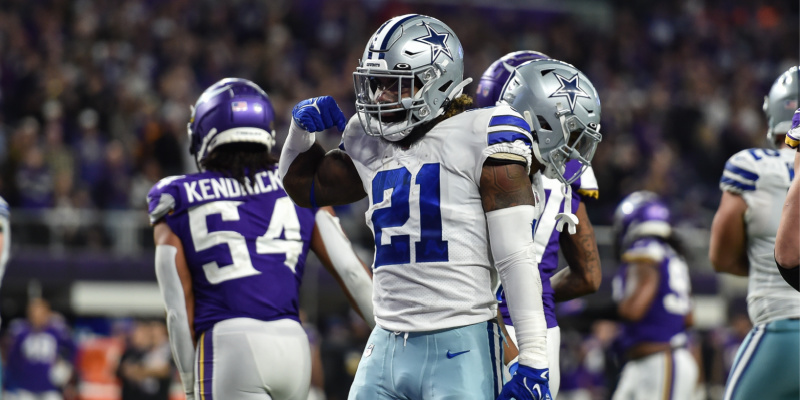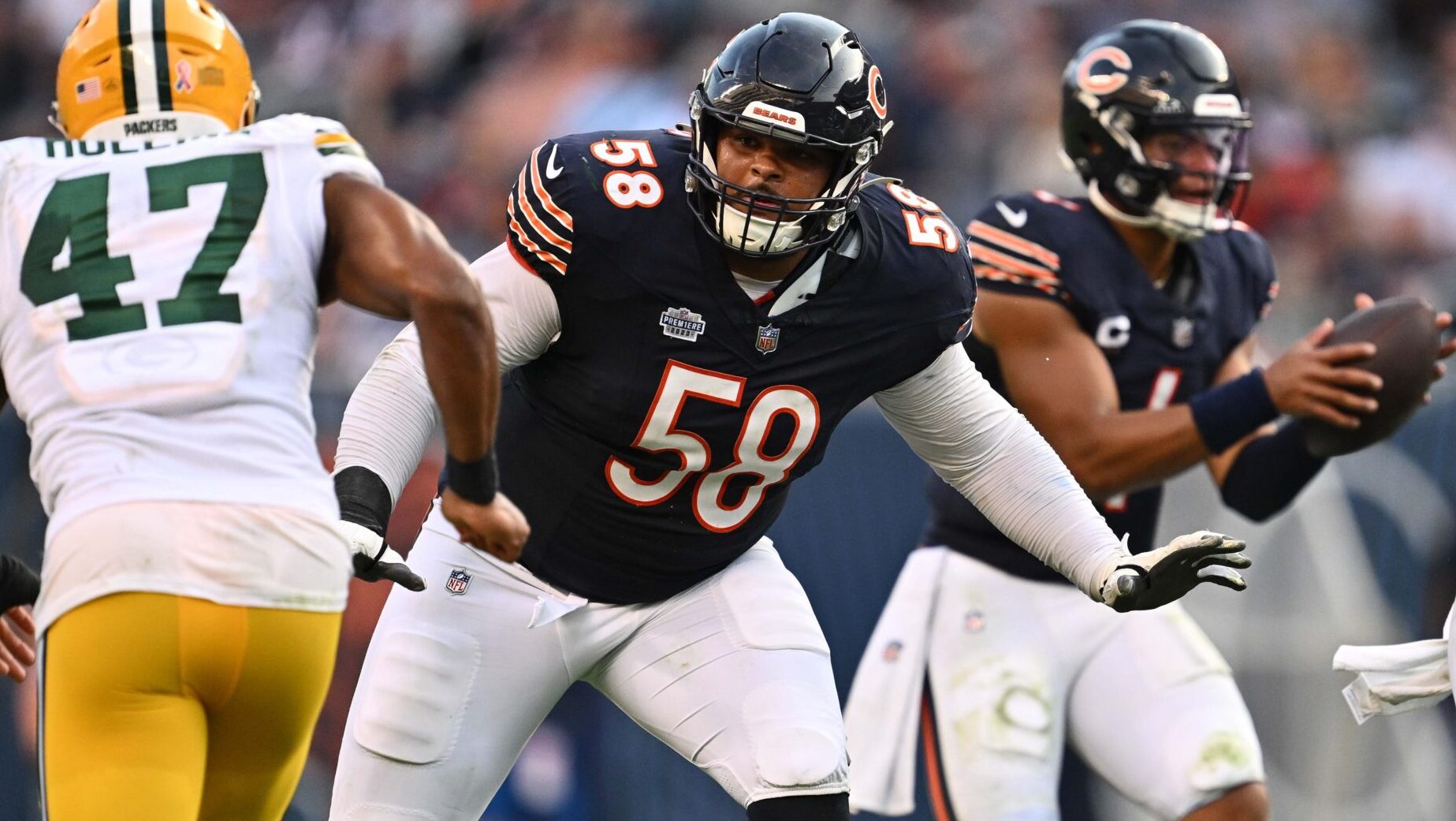Analysis
12/21/21
7 min read
7 PFF Stats You Need to Know

“Every player on every play.” PFF is best known for their player grades, but their Ultimate platform is a veritable treasure trove of information about every snap of the NFL and NCAAF seasons. With hundreds of statistics tracked and filters to apply, it can be a bit overwhelming to dive into, so we’ve compiled below what we consider some of the most interesting and helpful statistics from their platform. You may have heard of EPA, Big Time Throws, or pressure rate, but have you heard of these stats?
Rushing First Down + Touchdown Percentage (1DTD%)
2021 QB Leaders (min 25 atts):
Ryan Tannehill (63.0%), Teddy Bridgewater (53.3%), Jameis Winston (53.1%)
2021 RB Leaders (min 25 atts):
Jordan Howard (37.3%), Duke Johnson (34.6%), Jonathan Taylor (34.1%), Latavius Murray (31.0%)
Everyone has followed the race for the rushing title this season, from Derrick Henry’s early dominance to Jonathan Taylor’s recent claim to the throne, but let’s pose a question: what’s more valuable to a team – a nine-yard run on 3rd-and-10, or a two-yard run on 3rd-and-1? First downs still reign supreme in the league, and this stat reflects the players that best get to the sticks.
By taking the percentage of carries that a player gets either a first down or a TD, 1DTD% incorporates the power of a back as well as their field sense, effort, and vision. Yes, it definitely favors some of the players who get used more in short-yardage situations (as well as scrambling QBs), but it speaks to the effectiveness of a runner and isn’t exclusive to big backs – sub-200 backs Nyheim Hines and J.D. McKissic are excellent by this metric.
Rushing Yards Before Contact per Attempt (YBC/Att)
2021 RB Leaders (min 25 atts):
Chase Edmonds (2.8), J.D. McKissic (2.4), Dontrell Hilliard (2.4)
2021 Leading Teams (RB rushes only):
Philadelphia (1.9), Kansas City (1.8), Indianapolis (1.8)
With the popularity of yards after contact metrics, it’s easy to miss how helpful yards before contact can be in evaluation. While the leading rushers above certainly have some talent, it’s hard not to immediately notice that they don’t fall among the league’s best. That’s because YBC/Att isn’t great at telling you how good a rusher, is but is actually much better at telling you how effectively a team’s scheme and run blocking are setting up their backs for success.
There’s certainly some element of RB ability included, specifically their vision to hit the right hole and their acceleration or speed to get farther downfield before contact, but the best schemes and offensive lines will consistently give their backs more “free yards” before contact.
Receiving Threat %
2021 RB Leaders (min 25 snaps):
James White (36.8%), Christian McCaffrey (33.9%), Cordarrelle Patterson (27.7%)
2021 WR Leaders (min 25 snaps):
Cooper Kupp (31.0%), Davante Adams (29.0%), Antonio Brown (28.4%), A.J. Brown (28.0%)
2021 TE Leaders (min 25 snaps):
Jonnu Smith (30.9%), George Kittle (26.7%), Lee Smith (25.0%), Albert Okwuegbunam (24.0%)
Man, it’d be a lot easier to play defense if you could predict where the ball was going. Threat%, which is simply the percentage of receiving snaps where a certain player is targeted, is a great tool to quickly see how often a quarterback/offense tries to get the ball to a certain player in the passing game.
This can give you some fairly obvious answers, such as Cooper Kupp and Davante Adams being the focal points of their respective receiving rooms, but also highlights some role players who might go off with more snaps. or example, 11-year vet Lee Smith is only the third TE on the ATL depth chart, but has received an outsized amount of targets from Matt Ryan when he’s in the game. See Jonnu Smith come on the field? Watch out for the ball going his direction. Threat% helps the defense predict who’s getting the ball and adjust to stop it.
Quick Pressure Rate (QK PR%)
2021 Offensive Line Leading Teams:
Los Angeles Rams (11.5%), Tampa Bay (14.2%), Cleveland (17.2%)
2021 Defensive Line Leading Teams:
Buffalo (27.7%), Miami (27.1%), Carolina (27.0%), Kansas City (26.5%)
PFF’s pressure rate stat does a great job of accounting for how often an offense is putting their QB in danger, but it doesn’t distinguish between pressures where the QB holds onto the ball too long and pressures that are the fault of the offensive line. Here, quick pressure rate steps it up a bit. By taking the percentage of passes where a QB was pressured in 2.5 seconds or less, we can absolve the QB of much of the blame and instead hone in on OL or scheme failures.
On the flip side, it’s also possible to evaluate which defenses are most frequently getting in the QB’s face. Miami’s high defensive number is a bit of a surprise considering their defense is predicated on strong CB play, but by looking at their team leaders in quick pressures, we find a whopping 9 players with 100+ quick pressures. Led by a trio of DBs in Jevon Holland, Xavien Howard, and Byron Jones, it’s clear that the team is winning with blitzes.
First Contact (1ST)
2021 Leaders:
C.J. Mosley (106), Bobby Wagner (101), Eric Kendricks (93), Foyesade Oluokun (93)
This stat is exactly what it sounds like: how often does a defender make first contact with the ballcarrier? It’s easy to check tackling leaderboards, but not all tackles are created equal. Meeting a running back at the LOS and bringing him down is significantly more difficult than tripping up a ballcarrier who is busy evading another defender.
First contact certainly is related to tackling but ignores tackling technique or clean-ups and answers the question of “Who is fast enough and smart enough to get to the ball first?” A player can be taught to drag down an opponent, but athleticism and instincts to find that ballcarrier are much more difficult to improve on.
Average Depth of Run Tackle (ADOTK)
2021 DL Leaders (min 100 snaps v run and 5+ tackles):
J.J. Watt (-0.33), Von Miller (-0.15), Chase Young (-0.07)
2021 LB Leaders (min 100 snaps v run):
Zach Cunningham (1.52), Jamie Collins (1.70), Genard Avery (1.82), Pete Werner (1.86)
It sounds obvious, but the goal of run defense is to allow the ballcarrier to gain as few yards as possible. ADOTK looks at just that, identifying which players allow the least yards on tackles. J.J. Watt and Von Miller made their money rushing the passer, yet have reinvented themselves as elite run defenders whose average run tackle is actually behind the LOS. For a relatively simple statistic, it speaks volumes.
Passing Yards Allowed Per Coverage Snap (Yds/Cov)
2021 Safety Leaders (min 100 snaps v pass):
Jordan Poyer (0.14), Damontae Kazee (0.14), Trevon Moehrig (0.16)
2021 CB Leaders (min 100 snaps v pass and 20+ targets):
A.J. Terrell (0.33), Tavierre Thomas (0.40), Casey Hayward (0.53), Stephon Gilmore (0.57)
2021 LB Leaders (min 100 snaps v pass and 20+ targets):
Kyle Van Noy (0.28), Demario Davis (0.62), Jeremiah Owusu-Koramoah (0.65), De’Vondre Campbell (0.69)
The age-old question of individual DB stats is how to recognize the best players when they rarely see the ball. Interceptions and PBUs are impossible to accumulate when opposing QBs avoid a player out of fear.
Even more, simple counts of receptions allowed ignore the fact that a 50-yd bomb is a lot more damaging than a quick screen pass. Yds/Cov respects the snaps a defender plays without being targeted and differentiates between the damage that a reception does. A.J. Terrell and Stephon Gilmore have very different profiles this season, with Terrell an every-down LCB who’s been targeted at intermediate areas and allowed a low completion percentage due to a significant number of PBUs while Gilmore travels but is rarely even targeted. When throwing in the slot CB Tavierre Thomas, it’s clear that this metric isn’t biased towards a certain kind of player and instead truly reflects some of the best coverage defenders.
Information is only as good as how it’s used. With the rise of player tracking, more data is available than ever before. The best teams will be those that can cut through the noise and find the most relevant, undervalued stats to build a comparative advantage. With these seven PFF stats, those advantages are a step closer.








